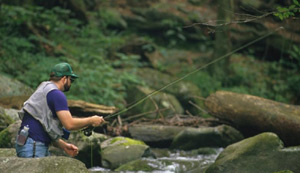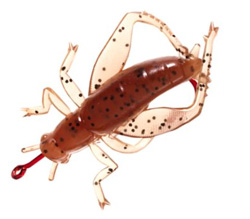
 Imagine yourself exploring and fishing a small, tranquil stream — lost in your own world, yet in the thick of trout country. Cascading waterfalls, riverbank critters and satisfying solitude are yours to enjoy and explore for the length of a day. Thousands of tiny creeks and rivers call North America home, and the wondrous colors and energetic tussle that the resident brookies, browns and rainbows exhibit is like discovering a new realm in the land of angling fun. Come take a walk off the beaten path and reap the rewards that small-stream fishing can offer.
Imagine yourself exploring and fishing a small, tranquil stream — lost in your own world, yet in the thick of trout country. Cascading waterfalls, riverbank critters and satisfying solitude are yours to enjoy and explore for the length of a day. Thousands of tiny creeks and rivers call North America home, and the wondrous colors and energetic tussle that the resident brookies, browns and rainbows exhibit is like discovering a new realm in the land of angling fun. Come take a walk off the beaten path and reap the rewards that small-stream fishing can offer.
Finding a Trout Stream
Finding a small stream that is rich with resident trout can be as simple as doing a little bit of homework before heading out. Chances are you drive by or over a small stream or creek every day on your way to work or out shopping. These can be teeming with hungry fish, yet are never given a second look from unsuspecting anglers passing constantly through. Stop your vehicle the next time you hurriedly pass by and discover what treasure may possibly await you under that man-made bridge.
Another trick is to call your local Fisheries or Environment offices in order to find out stocking records for the area you are interested in exploring. They may even go as far as letting you know quantities of fish that have been stocked, which can be a real bonus in finding the perfect honey hole. Road maps, handheld GPS units and topographical maps can help you find a gem in the rough by showing small streams and creeks and the roads to access them. Circle a half dozen of these urban prospects and take a leisurely drive through town to find the one that suits you, and the summertime trout, best.
Tackling Small-Stream Brook Trout
There are two routes to take when targeting small-stream brook trout — spinning or fly fishing gear. Each has its own merits, and it is really a matter of personal choice when it comes to picking a method. Whichever one you choose, the key aspect is to keep it light. Fishing rods should be short and line should be a thin diameter. Remember, the trout you will be targeting will not be monstrous, and neither should your equipment. Most of these urban dwellers will be measured in inches, not pounds, so light action tackle is definitely the way to go.
 |
| A small ultralite set-up, like the MicroLite spinning combo, makes it easier to get to those "hidden" streams. |
For spinning gear, my personal choice is an ultra light rod between 4 and 5 feet in length.A rod of this size will make it easier to travel through bushy undergrowth and to deal with small stream conditions.Line in the two to 4-pound test weight is all that is required.Most streams you will come across will be crystal clear, and many of the fish are extremely "line shy."Small line will enable you to trick finicky or smart fish more efficiently.
There is a large array of small-stream baits on the market, but I find it best to keep everything simple. Small number 0 spinners are extremely effective, especially in silver or gold tones. If the water happens to be a bit murky, a switch to a fluorescent hue may do the trick.
Tiny crankbaits have also fooled many a trout for me over the years and are most effective when "hotshotted." Hotshotting is a simple and effective technique for small-stream trout - here's how it works. Stand upstream of fast water and let your crankbait float down current until it is at the point where the rapids spill into the pool. Engage your reel and the bait will dive and wobble in place. Slowly let the bait slip back through the rapids and into the deeper water. Baits can be sent under fallen trees or log jams in order to access hidden fish. This is a great technique for tempting those fish that lazily and stealthily hide in the dark shadows of cover waiting for an easy meal to swim by.
Natural bait can be one of the best tricks in the book for fooling trout, (especially brookies and browns), and the rigging-up is very straightforward. Choose baits such as small red worms, grubs or hellgrammites in conjunction with small hooks in sizes 14 to 16. One or two small split shot should do the trick, and a slip-float can be added when cover or water action dictates it.
Where to Look for Small-Stream Trout
Small-stream trout are a very cover-orientated fish, and will seek out undercut banks, log jams or beaver dams for the protection and food source they provide. If these areas are directly downstream from a rapid area, you may have stumbled upon pay dirt. Try drifting a worm along these structure areas, or perhaps a dry fly or nymph if you are an avid fly fisherman. Insect patterns that imitate crickets or grasshoppers can be extremely effective if the stream passes through open fields with long grasses near the bank.
| If a trout stream passes through open fields, try using a cricket or a grasshopper artificial bait to imitate the insects. |
Another key area to pay attention to is the head of a pool, right where the rapids enter the deeper water. This is a prime feeding location and trout will travel to these spots routinely during the day to grab an easy meal.
One thing to keep in mind when fishing creeks or streams is to keep a very low profile and keep noise to a minimum. Trout can be very wary at times, and any sudden movements or sounds can create a sudden case of lockjaw in these fish. Keeping your shadow behind you and hiding behind cover can mean the difference between lots of fish or only a few.
Polarized sunglasses are a must for stream wading as they enable the angler to see what's below the surface by cutting down the glare that is present. Being able to spot boulders and wood, and feeding fish will help stack the odds in your favor for a successful outing.
Wading the local creeks and streams has been a rewarding and fulfilling pastime of mine over the years. Tangling with an 8-inch brook trout or even a juvenile rainbow smolt always seems to put a grin on my face from ear to ear, and reinforces the reasons why I love to fish. Try your hand at small-stream trout this season and tap into an undiscovered joy. The fishing can be great and the solitude even better, and the memories are sure to last a lifetime.
- 21584 views


